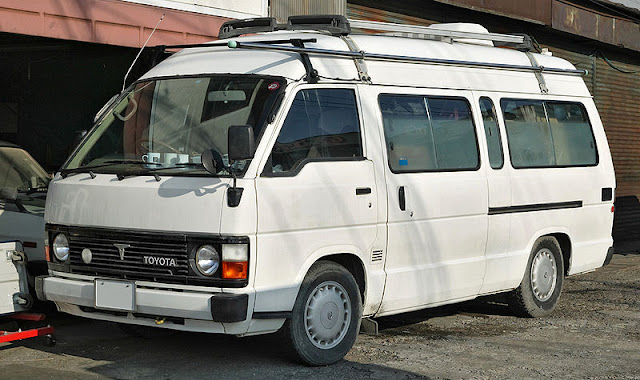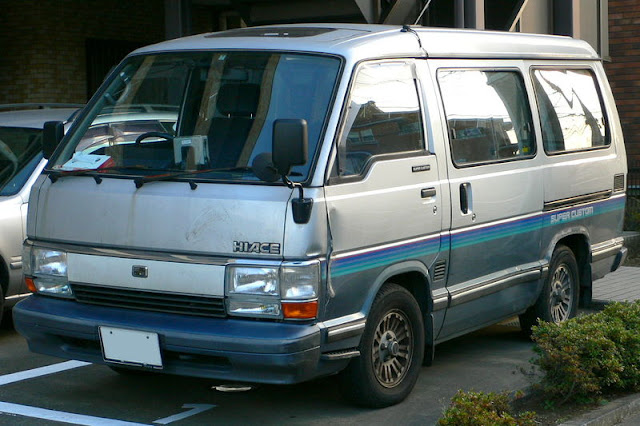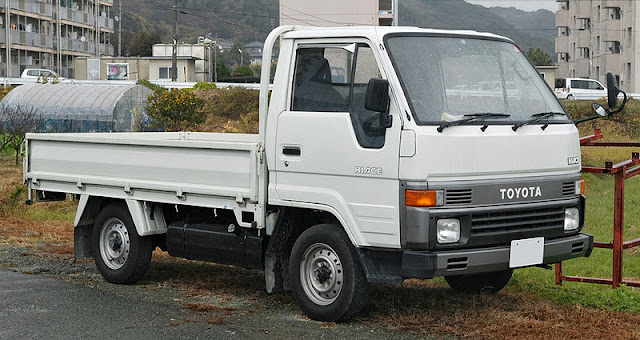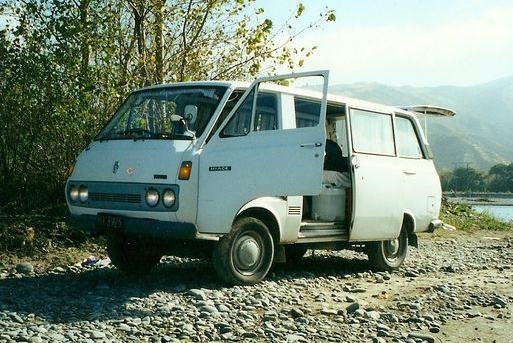Toyota Hiace Third Generation
January 27, 2011 – 10:42 am
 |
| Toyota Hiace Third Generation |
Toyota Hiace Third Generation Specifications :
Manufacturer : Toyota
Productions : 1989-2005
Engine : 4 cyclinders, 2000 cc and 3000 cc.
 |
| Toyota Hiace Third Generation |
 |
| Toyota Hiace Third Generation |
Photo Credit : Tennen-Gas, Mytho88.
October 6, 2010 – 2:00 pm
 |
| Toyota Hiace First Generation 1976 |
Toyota Hiace First Generation Specifications :
Manufacturer : Toyota
Productions : 1967-1977
Engine : 4 cyclinders
 |
| Toyota Hiace First Generation 1976 |
Photo Credit : Omer Simkha
April 26, 2011 – 12:53 pm
October 6, 2010 – 2:10 pm
 |
| Toyota Hiace Second Generation |
Toyota Hiace Second Generation Specifications :
Manufacturer : Toyota
Productions : 1977-1982
Engine : 4 cyclinders
Photo Credit : Aspiriniks
 Manufacturer : Volvo
Manufacturer : Volvo
 Productions : 1985-1987
Productions : 1985-1987
 Source : netcarshow.com
Source : netcarshow.com
In March 1985, Volvo Car Corporation showed the result of yet another cooperation in the field of luxury between Sweden and Italy, the Volvo 780, designed and built by Bertone in Turin. The event took place on the Volvo Cars stand at the 1985 Geneva Motor Show.
Exclusive Volvo coupes made in smaller series as top models have been around since the early 1960s. Volvo realised early the importance of expanding into new market segments with the help of such cars, hereby making more customers interested in the less exclusive models.
That worked with the 1800 series which stayed in production for almost thirteen years – with close to 48,000 cars sold, and it was also the case with the top model of the 240/260 series, the 262C.
The 262C was designed and built in Italy by Carrozzeria Bertone and came to the market in 1977. When the next generation of Volvo cars, the 760/740 were launched in the beginning of the 1980s, it did not take long before Volvo repeated the strategy; two saloon/estates were followed by a very exclusive coupe.
read more »
Tags 1985-1987, Volvo |
January 26, 2011 – 3:51 pm
 Manufacturer : Audi
Manufacturer : Audi
 Productions : 1985
Productions : 1985
 Engine : 441 kW (600 PS/591 bhp)
Engine : 441 kW (600 PS/591 bhp)
 Source : netcarshow.com
Source : netcarshow.com
The Audi Sport Quattro S1 was introduced at the end of 1984 as an update to the Audi Sport Quattro. The car featured a inline 5-cylinder engine that displaced 2,110 cc (128.8 cu in) and produced an officialy quoted figure of 350 kW (480 PS/470 bhp). However, the turbocharger utilised a recirculating air system, with the aim of keeping the turbo spinning at high speed, and the actual figure was in excess of 500 bhp (373 kW/507 PS) at 8000 rpm. In addition to the improved power output, an aggressive aerodynamic kit was added that featured very distinctive wings and spoilers to the front and rear of the car to increase downforce. The weight was lightened to just 1,090 kg (2,403 lb), and now accelerate from 0-100 km/h (62 mph) in just 3.1 seconds.
 Manufacturer : Subaru
Manufacturer : Subaru
 Productions : 1971-1989
Productions : 1971-1989
 Engine : GLF. Turbocharged engine
Engine : GLF. Turbocharged engine
 Transmission : 5-speed or automatic transmission
Transmission : 5-speed or automatic transmission
 Source : netcarshow.com
Source : netcarshow.com
The Subaru Leone is a compact automobile produced by Subaru from June 1971 to February 1989 when it was replaced by the Subaru Loyale, which was essentially the same car, only with a different name. The Leone was known as the “GL/DL” in North America. The Leone was offered in sedan and hardtop coupe format from launch and station wagon format starting in September 1972.
This nameplate covered three generations of compact Subaru; the dates given below are for North American-market vehicles.
- 1972 model year – GF hardtop coupe offered alongside existing G-series sedans and wagon.
- 1973 model year; G series replaced by new (Loyale) two- and four door sedans and 5-door wagon.
- 1975 model year – All-wheel drive wagon offered.
- 1978 – AWD-only pickup added, marketed as Subaru Brat in North America and Subaru Brumby in Australia. Sedans and wagons offered in plainer DL and fancier GL trim.
- 1980 – SECOND GENERATION – restyled body for passenger cars. Two-door sedan dropped, replaced by 3-door hatchback on a shorter wheelbase than the others, available with AWD. Pickup continues on old body. 5-speed manual transmission supplied with 2WD GL sedans and wagon and GLF hardtop.
- 1982 – Pickup now restyled, catches up with passenger cars.
- 1983 – GL now midlevel trim, fancier GL-10 trim for all bodystyles replaces hardtop-only GLF. Turbocharged engine (“Turbo-Traction”) available on AWD GL-10s. AWD now available on sedans and hardtops, and with 5-speed or automatic transmission for the first time. Minor trim changes for all models include “honeycomb” grille texture, Mercedes-style ribbed taillight lenses, and plastic-covered bumpers (except North American 2wd models). GL and GL-10 now have quad headlights.
- 1985 – THIRD GENERATION sedan and wagon with larger, angular body. Quad headlights now on base DL, composite headlights on GL and GL-10. Hardtop discontinued, second gen. hatchback and pickup continue without change.
read more »
 Manufacturer : Schwinn
Manufacturer : Schwinn
 Productions : 1936
Productions : 1936
 Source : OldRoads.com
Source : OldRoads.com
read more »
January 18, 2011 – 9:07 am
 Manufacturer : Toyota
Manufacturer : Toyota
 Productions : 1978-1984
Productions : 1978-1984
 Engine : 993 cc 2K I4, 1166 cc 3K I4, 1290 cc 4K I4
Engine : 993 cc 2K I4, 1166 cc 3K I4, 1290 cc 4K I4
 Transmission : K40 (4-speed manual), K50 (5-speed manual)
Transmission : K40 (4-speed manual), K50 (5-speed manual)
 Source : wikipedia.org
Source : wikipedia.org
Description : The 60 series, introduced in 1978 was better known, being the first to be extensively sold outside Japan. It was offered with 993 (KP60 2K), 1,166 (KP62 3K) and 1,290 cc (KP61 4K) engines. Three- and five-door hatchbacks were offered in export markets, although a distinctive 5-door wagon variant was sold in Japan, Hong Kong and Germany. Trim levels were Standard, De Luxe (also known as DX in some markets), GL, XL, S, and SE.
In 1980 the Starlet was facelifted to include square headlights and a second facelift followed in 1983 to incorporate a slant nose front end, and lower hatch opening.
The KP61 was the only Starlet ever sold in the USA from 1981 to 1984, and the Toyota Corolla FX replaced it in 1985. The 1981–1982 models came with standard 5-speed manual transmission and tachometer. It is an equivalent to other markets’ S model. The 1983–1984 models were additionally offered with Electronic Fuel Injection (EFI) with the 4K engine, but with 4-speed manual transmission, and similar to other markets’ XLi model.















